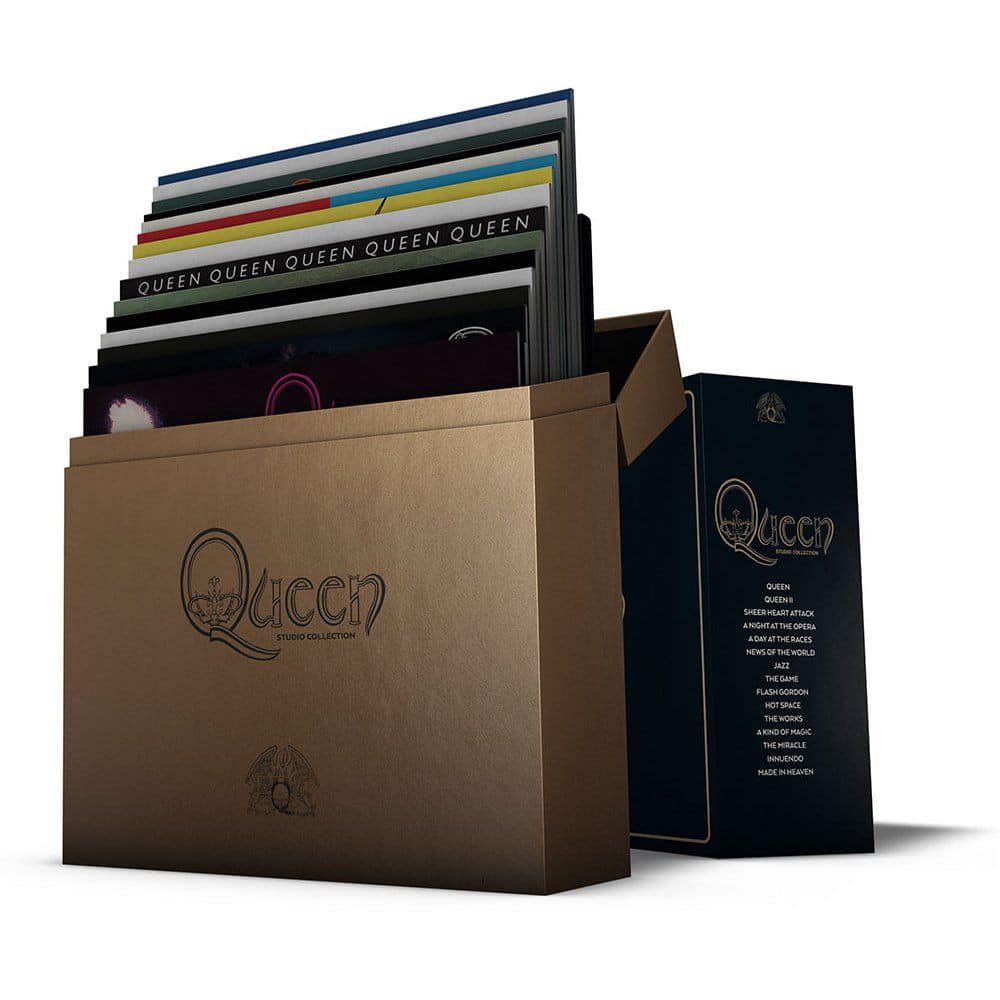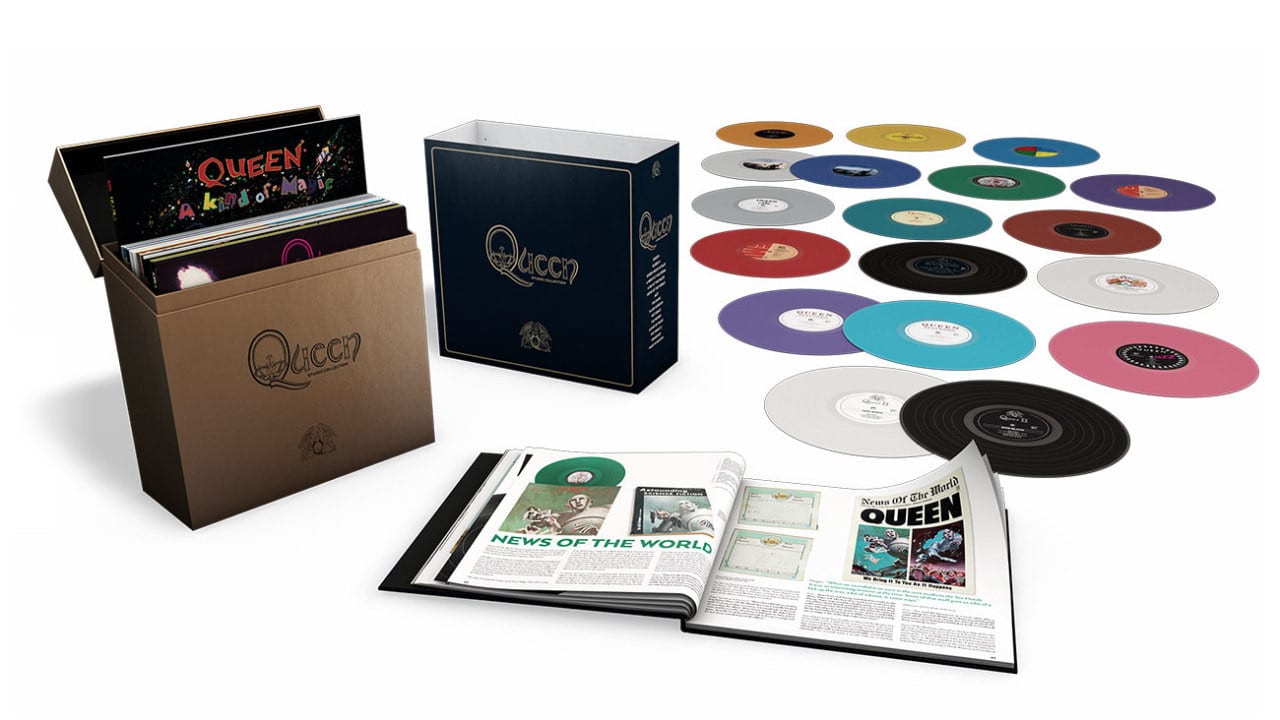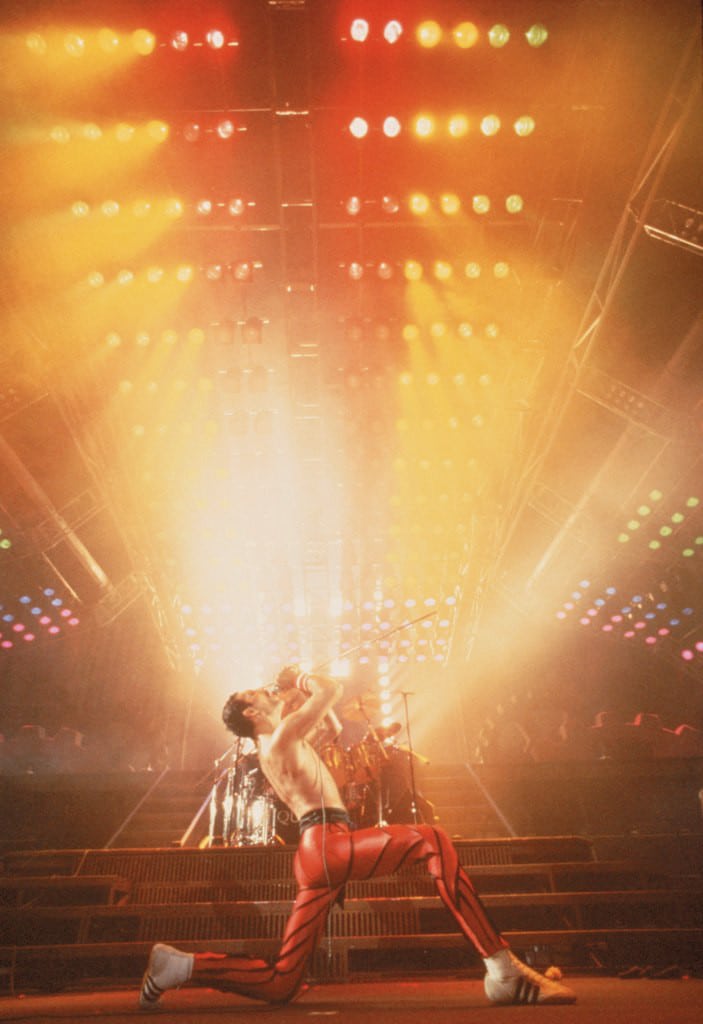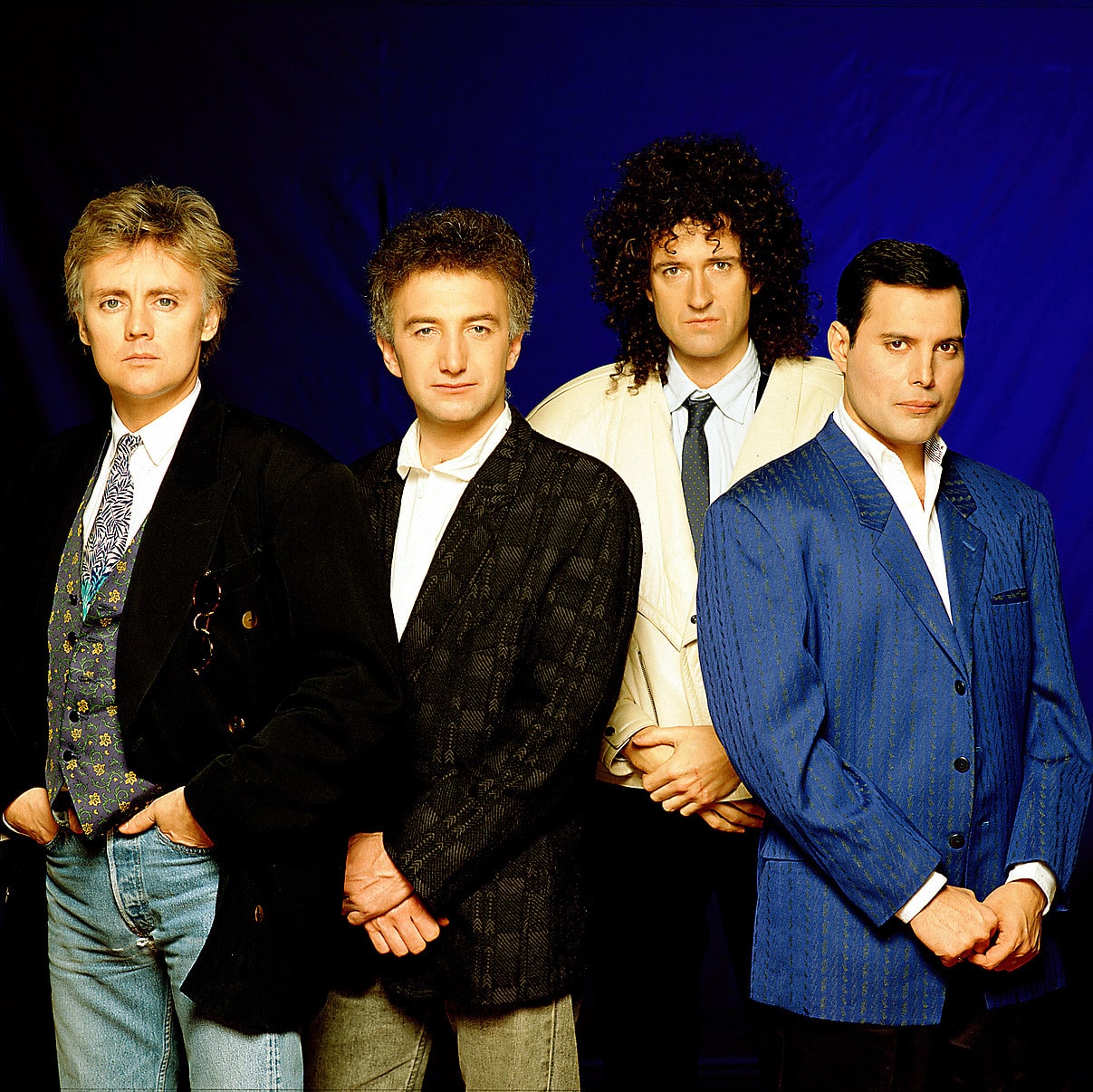The Article
THE QUEEN STUDIO COLLECTION PT.1
14th May 2016

Recently remastered with attention to detail, Paul Rigby reviews the new Queen vinyl box set
This is Part One of a two part feature that centres upon the recently released Queen box set that features that band’s studio output as half-speed vinyl issues pressed on coloured vinyl. Part 1 focuses on reviewing the box set itself while Part 2 talks to the men behind the project and investigates some of the audiophile and technical apsects behind it.
Queen was recently the recipient of a vinyl box set that featured and still features each of their 15 studio albums including: Queen(1973), Queen II (1974), Sheer Heart Attack (1974), A Night At The Opera (1975), A Day At The Races (1976), News of the World (1977), Jazz (1978), The Game (1980), Flash Gordon (1981), Hot Space(1982), The Works (1984), A Kind of Magic (1986), The Miracle (1989), Innuendo (1991) and Made in Heaven (1995).
There are a few intriguing wrinkles to this collection. Firstly, both Innuendo and Made In Heaven were formatted for CD, each holding a relatively long running time, so the contents had to be edited down to fit them on to the two sides of the original vinyl editions. Now, specially for this edition, for the first time, these two albums have been cut at full length as double vinyl LPs.The box-set also features coloured vinyl. Each album has been given a different colour, in keeping with its original artwork. The coloured discs have been custom-produced especially for this set by the German pressing plant assigned to this box set, Optimal. When this feature was first announced, it struck a certain amount of horror into this scribe’s heart plus the fans (and some people actually working on the box set, it has to be said). We’ll get back to the sonic output of the colour later. That also means that the coloured vinyl headline hits the odd inconsistency because A Day at the Races has a black sleeve and so arrives in black vinyl which is not coloured at all, of course.
Finally Queen II originally never had a designated A-side or B-side but Side White and Side Black. For this new edition, the album has been cut on two separate discs, black and white, each with a custom etching on the reverse side. Again, one disc is your basic black vinyl so, of the eighteen slabs of coloured vinyl seen here, only sixteen are actually coloured in anything but black.
In terms of album titles, the anomaly is Flash Gordon, which technically is a soundtrack (although the group saw it as a studio release – it was always under-rated) but what we don’t see here are any official live albums such as Live Killers (1979) or Live Magic(1986) which some will see as a lost opportunity.
In addition to some reported intensive work seeking and tracking down superior tape sources (i.e. five tracks on the Innuendoalbum, were improved after the discovery of better sources during this period), the mastering was completed using the original master tapes, it was then de-noised and converted to digital files at 24bit/96kHz where more work was done. We’ll learn more, in Part 2, about this process while tackling audiophile concerns about the use of digital files during the chat with principle mastering engineer, Bob Ludwig.
The cut was performed by Miles Showell at Abbey Road using the half-speed process using a Neumann VMS80 lathe boasting cutter-head amplifiers fitted with custom designed RIAA filters. There’s a more detailed chat with Showell, elsewhere in Part 2.
The box itself is covered by a slip-on card sleeve with pictures of each album sleeve and their attendant discs on the rear. Slip off the outer sleeve to reveal a sturdy gold box with the Queen logo and crest on the front. The top-fitted flip lid reveals all of the albums plus a 108-page, hardback book featuring a host of interesting information plus rare photos, memorabilia, foreign sleeves and more.
Each album is pressed on 180gm vinyl, contained in plastic coated inner and separated from any inserts to prevent damage. The thick cut sleeves are held within thin, resealable plastic bags. These bags are relatively fragile and easily ripped so care must be taken.
As you can see, this set does not endeavour to present to you a complete duplicate of the original releases in all their glory but a tweaked, often improved, suite of LPs. A further example of this can be seen in the packaging for the album, Jazz. The original had no lyric sheet and a poster fixed inside the gatefold sleeve. The new edition puts the poster inside the sleeve and prints lyrics on the outside of the poster.
For those who do not want to purchase this mighty set, the included albums are available, separately, to buy on black vinyl.
SOUND QUALITY
Before I dive into the sound testing, a brief explanation of the process. There has been a variety of pressings of the Queen catalogue sold at home and abroad over the years. I’ll be looking at the major UK pressings as a means of comparison here. Hence, I will compare the new box set with the original pressings, a Millennium version which covered a selection of albums which were released in 1999 and appeared to have been based upon a 1998 digital remaster plus a later 2010 series of releases which seemed to mop up the rest of the (delayed Millennium) batch and which were also based on the 1998 masters but from a different pressing. Finally, as the box set features the new, rather contentious, Optimal coloured vinyl pressings. I’ll be comparing those with the new black vinyl pressings to see if Optimal’s coloured pressings are, indeed, of audiophile quality.
To begin, I listened to the 1974 original pressing of Sheer Heart Attack and played In The Lap Of The Gods which offered an interesting mixture of treated vocals from Freddie Mercury, some piercing Roger Taylor vocal crescendos, percussion from the same, guitar and piano.
The new master, I’m happy to report, was superior in just about every aspect. Most noticeably, the upper mids and treble were opened up dramatically. For example, the early parts of the track feature a shimmering gong affect which wafts around the stereo image. This instrument was much more characterful and offered greater amounts of information than the original. Staying in this frequency band, Roger Taylor’s crescendos were clearer now with the original’s slight compression removed. Because of the latter, the overall track was now easier on the ear without any of the inherent listening fatigue from the original. Moving down the frequency ladder, Brian May’s rather claustrophobic guitar inserts, which previously had a muffled aspect, provided complexity in terms of the plucked strings while the piano and lead vocal both had a free and natural air.
In terms of percussion, the original had a bloated, boomy lower end. Now, the percussion had a focused and tighter presentation that removed the swollen lower frequency aspect but did provide a series of clean strikes. Moving to A Day at the Races and playing the 1999 release from the 1998 remaster of Somebody To Love, I was beginning to see a trend because the new master benefitted again from that open and airy suite of upper mids and treble that gave the overall presentation a rich, deep, spacious aspect that allowed the vocal to sound simple and pure while cymbal strikes had a welcoming fragility. Percussion, from Roger Taylor roamed around the wider and more fulsome soundstage while the bass from John Deacon was sharper and rounder.
The 1999 release did suffer a touch from a sense of dryness, as though it had been pushed through a digital system with slightly restrictive ADC (Analogue-Digital Convertor) equipment. The music was also spare and empty in feel so that musicality suffered. Not with this new master, though. In fact, the effect was exactly the opposite. With the new master, there was a far more natural quality in both the lead guitar and Mercury’s lead vocals that exuded feeling and emotion because there was space to allow the nuances and subtleties to manoeuvre.
I next turned to the album, Jazz and the 2010 release from the same 1998 master and Dead on Time. This was interesting. If anything, this 2010 issue offered greater bass impact than the 1999 release of A Day at the Races yet this 2010 pressing of Jazz had a distinctly strident air. Percussion was sharp and abrupt while parts of the Mercury lead vocal were distinctly bright in their aspect. More than that, the Mercury vocal was right up in your face, lacking emotion and relying only on impact to make a mark on the performance. The new master pushed the Mercury vocal back into the mix while the percussion was characterful and blended into the band’s overall presentation, giving a more supportive role to the music rather than adding an unpleasant edge.
What this master did do was remove distortive noise from the master, encouraging you to increase the volume to really allow the master to rock…and rock it certainly did. Now offering a more balanced sound signature, the track resembled a force of nature as the blend of manic guitar and flailing percussion supported the lead vocal. This is the first master I have heard that really allows this track to flow as it truly should.
So much for the new master as a qualitative item in its own right. What about the coloured vinyl aspect of the vinyl itself? Coloured vinyl has a historical reputation for lowering the sound quality of music as the cartridge tends to play the pigment as much as the music. To test this area, I compared the pure black and the newly coloured versions of A Night at the Opera and the Death on Two Legs, Freddie Mercury’s vicious letter to an old band manager.
This particular comparison is pretty short and sweet because I couldn’t hear any differences at all. I did an A-B comparison, B-A, back to A-B, etc. As such, the result is, well, a result…for Optimal and their new coloured vinyl implementation. I just hope this new technique spreads around to other pressing plants.
CONCLUSION
In terms of packaging and presentation, the new Queen box set should really be viewed as an archival, audiophile collection. Its not supposed to provide an exact replica for the original releases. It’s supposed to provide the best possible quality for the information to hand and do so with care and attention.
As for sound quality, for any Queen fan, look no further than this box set or the individual vinyl releases for the best possible sound version of the Queen catalogue. Of true audiophile quality and offering superb sound in all areas – especially that open and spacious suite of upper frequencies – this new Queen campaign is a complete triumph.








I’m surprised to see no mention of the excessive use of compression compared to original releases. I was even more surprised that they would do that after going to so much trouble. The later albums are most affected – The Game DR9 v DR13 for example.
I think I went into detail re. the sound quality for a selection of older issues and this box set and then talked about where that sound had come from in Pt2: https://theaudiophileman.com/queen-studio-collection-pt-2-engineers/ It’s been a while now (what, 7, 8 years or so) but I think compression is addressed in there. I didn’t have compressive issues during my sound test though otherwise I would have talked about them.